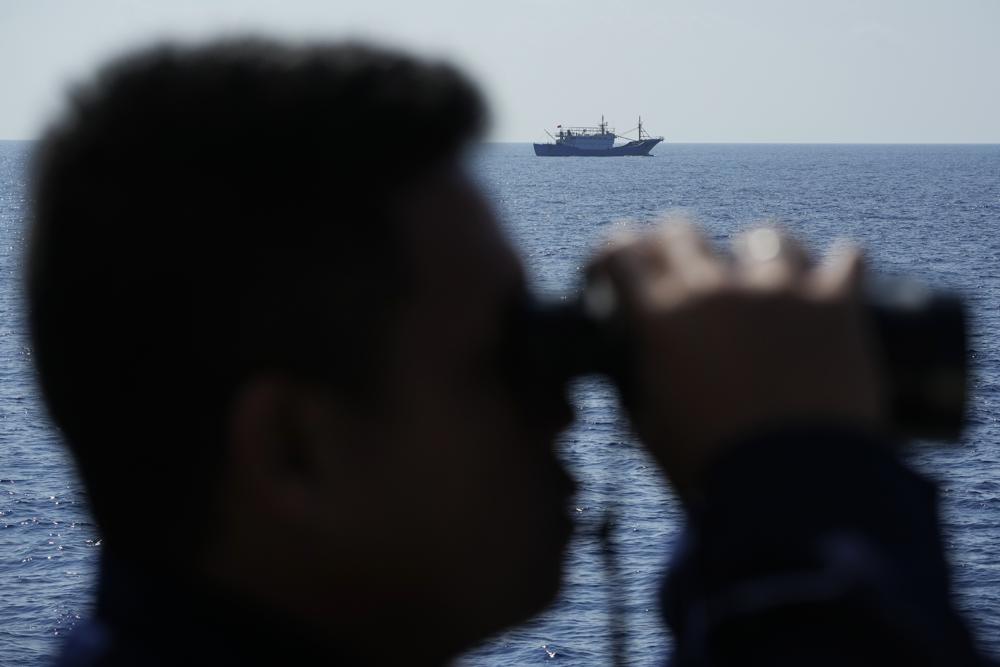A suspected Chinese militia ship passes as members onboard the Philippine Coast Guard BRP Malabrigo drives them away from Philippine-occupied areas in the South China Sea on Friday, April 21, 2023. (AP Photo/Aaron Favila)
ABOARD BRP MALABRIGO (AP) — When two Philippine coast guard vessels set out to patrol the volatile South China Sea recently, they had to face more than China’s growing territorial ambitions.
The patrols are a constant battle against sun, sea, stress and gnawing isolation. The Associated Press joined a recent voyage, which provided a glimpse of what it’s like for Filipino coast guard personnel to work on the front lines of multiple geopolitical conflicts in one of the world’s most fiercely contested seas.
The BRP Malabrigo and BRP Malapascua, Japanese-built 44-meter (144-foot) patrol ships, planned to make a circuit of disputed islands, islets and reefs claimed by the Philippines in the Spratly Islands, some occupied by Philippine garrisons and some by Chinese military installations.
China has rapidly built up its military presence in the area in recent years, pushing back other claimants like the Philippines and building artificial islands with airstrips and military garrisons. The rich fishing archipelago is believed to sit atop vast undersea deposits of oil and gas.The Philippines dispatch regular patrols to assert their claims to the islands, spot encroachments, and resupply Filipino sailors stationed on the islands. Arrayed against far larger and more powerful fleets of Chinese coast guard vessels, navy warships and seaborne militias, the Philippine coast guard says its patrol vessels often face David and Goliath confrontations, especially near Beijing’s artificial island bases.
Life on patrol was a mix of hard work and claustrophobic leisure. It was often so hot that sailors got dizzy after a few minutes outside, so crewmembers spent most of the down time between their four-hour shifts in tiny, air conditioned cabins. When there was room in the mess hall, a few people might gather to watch a film or sing on the karaoke machine — a Filipino necessity. Some liked to take walks in the ship’s narrow passages.
The sailors, a mix of sunburned veterans and sprightly recruits, brought cellphones brimming with personal photographs and videos and games.
The two ships visited one or two destinations a day, working without interruption day and night. The easiest stops were at places occupied by Filipino forces, where the ships sent motor launches to deliver basic supplies like water, crude oil and cigarettes. At one, thirsty sailors offered dried fish in exchange for extra drinking water.
Visits to Chinese-controlled areas were harder. At one reef, the patrol encountered more than 100 small Chinese boats, suspected of belonging to the militia, anchored in groups. The Filipinos lowered launches and demanded the boats leave Philippine waters. The Chinese boats did not reply, or leave.
The patrol faced off with the Chinese Coast Guard at Chinese-occupied Subi Reef, and later at the Second Thomas Shoal, which is occupied by Filipino sailors on a beached, crumbling navy ship, surrounded by Chinese ships.
These encounters are tense, drawn-out affairs. Chinese coast guard and navy ships shadowed the patrol for more than an hour, and over the radio accused the Filipinos of intruding into what Beijing claims as its territorial waters and ordered them by radio to leave or face unspecified counter actions.
A radio operator, holding a paper script in the corner of the bridge, asserted Philippine sovereign rights and asked the Chinese ships to stay away and abide by international anti-collision regulations.
Meanwhile, the rest of the bridge was quiet, and intensely focused. A radar operator watched intently for tiny changes in the other ship’s speed or bearing. When it approached one knot faster, the commander barked an order to alter the Malabrigos’s speed in response. The encounter lasted for more than an hour.
Commander Julio Colarina III, 41, was a 24-hour fixture on the bridge of the Malabrigo, where he slept on a folding bed when off duty. He’s a second-generation defender of the Philippines’ territorial interests. His father, a retired navy man, spent a year in the 1970s garrisoning Philippine-occupied Thitu Island.
As crew members rested between shifts on the bridge, the strains of classic rock hits like “Hotel California” could be heard from the mess hall. One night, a sailor celebrated her birthday in stark austerity: colleagues put a candle on an omelet and prepared sardines, fried fish and rice to mark the occasion.
Asked for a birthday wish, the 27-year-old said, “peace and good health always.”
On April 23, the second to last day of the voyage, journalists witnessed a cliffhanger encounter when a Chinese coast guard ship blocked the Malapascua as it tried to steam toward the Second Thomas Shoal. The crew fell silent. The Malapascua’s Capt. Rodel Hernandez said a near-collision was averted when he abruptly reversed his vessel’s direction and shut off its engine to bring the vessel to a full stop.
The journalists captured the dangerous confrontation on video and cameras, sparking a new round of arguments between Manila and Beijing. The Philippines criticized China for “highly dangerous maneuvers” that it said endangered the Philippine patrol vessels and its crewmembers.
China said the Filipino vessels barged into its territorial waters laden with journalists in a “premeditated provocation designed to deliberately create a friction” intending to lay the blame on Beijing.
Petty Officer 2nd Class Reggie Lobusta, who has been deployed to the disputed region multiple times in the past, said he felt like he’d just finished yet another round in a long boxing match, with no end in sight.
“There will be far worse than what we’ve encountered if these problems are not addressed properly,” Lobusta said.
The patrols are considered some of the most difficult assignments in the Philippine Coast Guard. The entire crew was to undergo brief sessions with psychologists in a “stress debrief” after their return to shore, Colarina said, and received half a month’s salary as hazard pay.
As the Malabrigo headed home after seven days, more crewmembers than usual milled and chatted on the deck, taking selfies with cellphone cameras as the sun set in the background.
“It’s our morale booster — the sunsets, sunrises, dolphins and green turtles,” said Lobusta. “It will break my heart when I retire and leave this ship and my second family here one final time.”
Copyright 2021 Associated Press. All rights reserved.










































